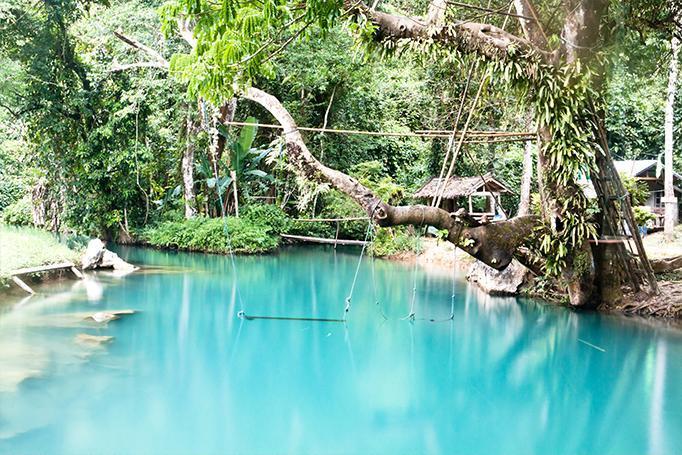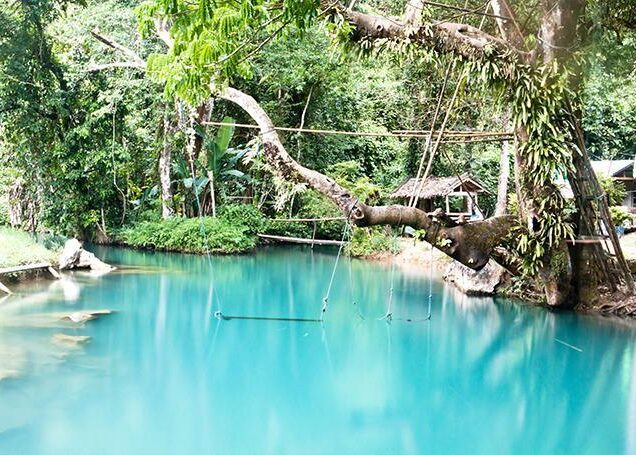
Lanzarote Canary Islands Spain
Lanzarote Canary Islands Spain Hyatt Secrets Bedroom Lanzarote Canary Islands Spain Timanfaya NP Lunar Landscape Lanzarote Canary Islands Spain Hyatt Secrets Gym Lanzarote Canary Islands
Our adventurous tours of Laos take you to the capital, Vientiane, a city so quiet that in 1970, there was only one set of traffic lights in the entire city! Maybe hire a bicycle and explore the local streets and markets. North from Vientiane, you’ll enjoy stunning scenery on the way to Vang Vieng, a peaceful town situated on a plateau with stunning surroundings of limestone caves and waterfalls. On our Laos tours, you will enjoy a glimpse into the Hmong and Yao tribes, which inhabit the area.
The local limestone caves are also visited on our Laos Tours and these caves are renowned in ancient mythology. Vang Vieng is an excellent place to try the local cuisine. After a delicious traditional meal on one of our tours of Laos, you might feel energised enough to hire a bike and cycle to see the limestone karst formations. Luang Prabang refers to the holy Pra Bang, Laos’ most sacred image of the Buddha given to Fa Ngoum and this town is renowned for a fascinating history and some of the friendliest people in South East Asia. Located 300 metres above sea level on the upper Mekong River, the town is dominated by Phousi – the marvellous mountain that sits at its heart. So take one of our exciting tours of Laos and you’ll discover Lao, French and Lao-French colonial influence as you admire the city’s buildings and architectural highlights – all of which you can see on foot.


Lanzarote Canary Islands Spain Hyatt Secrets Bedroom Lanzarote Canary Islands Spain Timanfaya NP Lunar Landscape Lanzarote Canary Islands Spain Hyatt Secrets Gym Lanzarote Canary Islands
Landlocked and often overlooked, Laos can offer travellers a less frenetic Southeast Asia experience compared to its more popular neighbours, Thailand, Vietnam and Cambodia. Travel in Laos involves shifting down a few of gears, accepting a slower, more languid pace of life and taking the time to appreciate Laos’ greatest asset; it’s chilled-out, friendly people. Its years of cultural isolation has ensured many traditions live on and its authentic and charming character is one of the biggest draws. Other attractions include its natural landscape which folds and creases in dramatic ridges and river valleys, often drapped in vibrant foliage. There are caves to explore, jungles to trek and mountains to scale making it a popular adventure destination. Culturally, Laos is surprisingly diverse, from the vibrant garb of the northern hill tribes, to the Buddhist wats and temples of the lowlands and the lingering French colonial influence.
Laos’s currency is the kip (symbol: ₭ or LAK) which breaks down to 100 att, although you will not see any money in such small denominations and there are no coins in circulation. Notes come in 500, 1000, 2000, 5000, 10,000, 20,000, 50,000 and 100,000 kip denominations. While technically it is against the law to pay in foreign currency, many tourist services will accept Thai baht or US dollars, particularly if it is for a large amount as paying large amounts in kip can be cumbersome.
ATMs are increasingly common in major towns and cities, but can be unreliable, so it is best to carry a mixture of cards (Visa or Mastercard are most accepted) and cash in USD and baht. It is important in Laos, not to rely on cards as your sole means of payment. Travellers cheques are another way to securely carry your travel funds and should be accepted at most banks throughout the country. The maximum withdrawal from a Laos ATM is generally between one and two million kip.
As one of the world’s poorest nations, Laos is an inexpensive country for travellers. Food is cheap, particularly if you are eating at street stalls and cheap local restaurants. A budget dinner costs in the vicinity of 20,000-50,000 kip (US$2.50-7.00), a bottle of water around 5,000 kip (60c) and a large bottle of beer laos is usually between 10,000-20,000 kip (US$1.25-$2.50). Entry fees for museums and short excursions tend to be between 10,000 and 30,000 kip.
Bargaining is part of the culture in Laos, and it is approached with a relaxed and fair mindset where both vendor and buyer come to a mutually happy arrangement. Generally speaking sellers in all but the most touristy areas will start with a fairly realistic price and will only expect to come down a little bit. Aggresive haggling over small amounts is not considered appropriate and if you quote a price that is too low the vendor may lose interest.
Curled around the banks of the Mekong River near the Thai border, the Laos’ capital of Vientiene does not have the energy of some of Southeast Asia’s other capital cities but is a nice place to enjoy a drink overlooking the Mekong River. It is also home to the national museum and nearby Xieng Khuan Buddha park with its bizzare collection of statues. To the north, Vang Vieng is an outdoorsy town set amoungst towering limestone outcrops and verdant rice paddies where you can go rock climbing, caving, river tubing or hiking. Next up the road is Luang Prabang is perhaps Laos’ most alluring destination, with elegant temples, wats and French shopfronts laden with faded opulence of times gone by. The nearby Kuang Si waterfalls are breathtaking and make a popular day trip from the city. Further afield, the northern towns of Phongsali, Luang Namtha and Udomxai are potential starting points to explore the remote north with its hiking opportunites and ethnic minority villages. In the south, Savannaket offers preserved French-colonial architecture. Nearing the Cambodian border, Pakse has nearby Angor-style ruins and Si Phan Don, the idyllic four thousand islands river archipelago.
The electricity supply in Laos runs at 220 volts AC. The most common outlets are two pin sockets taking flat or round prong plugs. It is recommended to pack a universal adaptor to cover your bases. The Laos power supply can be erratic and may be switched off at night in smaller towns, so be aware of surges to protect your devices and pack a torch if heading to remote villages.
Laos is a diverse nation and has, at times, been estimated to have up to 149 ethinic groups. They are simplified into three main groups, based on what altitude they are found – the Lao Loum (lowland Lao), Lao Theung (Lao of the mountain slopes) and Lao Soung (Lao of the mountain tops). The Lao Tai is the fourth group which is often combined into the Lao Loum and, although they are closely related, they have resisted adapting to mainstream culture and many still live according to their traditional tribal ways. Over half of the population is Lao Loum and their language is the national language.
Around 60% of the population follow Theravada Buddhism, including most of the lowland Lao. The other predominant religious influence is spirit worship called Phii worship or animism which, although it is official banned, coexists harmoniously alongside Buddhism. It is particularly strong amoungst tribal Lao. Other religions present in Laos include a small number of Christians, Muslims and Cham.
It is important to dress conservatively in Laos, which means covering shoulders and thighs for women and men should not go shirtless. In keeping with Buddhist traditions, feet are considered unclean and you should not step over anyone and if you accidentally kick someone immediately apologise and smile. A person’s head is considered sacred and should not be touched, even for children. Shoes are generally removed before entered a home or temple and if sitting, feet should always point away from any religious image or statue.
Laos is famously laid back and friendly and visitors will find they will receive a more welcome reception if they smile a lot and greet locals with sabai di (hello). Strong emotions are tabboo and if you show anger, don’t be surprised if locals respond with amusement or simply walk away.
Laos has an area roughly the size of Great Britain and is a landlocked nation bordering with Myanmar, Thailand, Cambodia, Vietnam and China. Mountains and plateaus cover almost three quarters of the land making the scenery dramatic with river valleys and mountain passes. The northern half of the country is characterised by jagged mountain ranges. The Annamite Chain, which runs down half the length of the country, includes the Khammuan Plateau with its limestone grottoes and steep gorges.
The Mekong River runs parallel along the length of the country, marking part of the border with Thailand before flowing into Cambodia. It is navigable in places but the waterfalls and rocky islands around Si Phan Don mean it cannot be practically used for transport between Laos and Cambodia. The Mekong floodplains through the central part of the Laos portion of the river is where most of Laos’ rice is cultivated and makes up the most tropical part of the country.
The first extensive Lao kingdom was formed by Fa Ngum in the mid-14th century, an Angkor-educated Lao prince who was given an army from the Khmer with which to gain control of the middle-Mekong and stave off the threat from the Thai kingdom of Sukhothai. He founded the kingdom of Lan Xang with his capital at Xiang Dong Xiang Thong (later renamed Luang Prabang). This kingdom persisted until the early 18th century although it suffered setbacks from invasions and succession disputes.
After a devastating, though ultimately unsuccessful invasion by the Vietnamese, the kingdom recovered under the rule of King Visoun who came into power in 1501. He was succeeded by his son and then his grandson Setthathirat who moved the capital from Xiang Dong Xiang Thong to Viang Chan (later renamed Vientiane by the French) in response to the threat of invasion from Burma. Setthathirat was Laos’ greatest builder, constructing Wat Xieng Thong, the most beautiful surviving Buddhist temple in Laos, as well as several monasteries in Luang Prabang, a new palace in Viang Chan, That Luang stupa and a number of royal temples.
The kingdom endured until the death of King Suriya Vongsa whose son was put to death for adultery leaving the line of succession uncertain. This led to the rulers of Luang Prabang and later Champasak in the south to declare independence, fragmenting Laos into several weaker kingdoms that were obvious targets for the Siamese. This led to Siam (Thai) lordship over Laos, with all kings requiring prior approval before being crowned and regular tributes to be paid.
The French had gained control of neighbouring Cambodia by 1863 and eventually won Laos from Thailand in 1893 when a French warship travelled up the Chao Phraya River to Bangkok, forcing the Thais to sign over all territory east of the Mekong River. Administrative control was returned to Vientiane and the French brought in Vietnamese civil servants and French officials to enforce colonial control.
The catalyst for change in the area was World War II where the Japanese ruled Laos for just six months before the end of the war. The Lao Issara (free Laos) group formed an interim government and declared independence but infighting and foreign interference caused continued unrest with control of the country returning to the French until full independence was granted in 1953.
The Vietnam War led the North Vietnamese and the Americans to use Laos to gain strategic advantage, although according to an international agreement signed in Geneva in 1962 Laos was a neutral state and the presence of foreign military in the country was forbidden. This neutrality was flouted by both sides with the North Vietnamese using Lao territory to move troops and supplies into South Vietnam and the Americans training the local Hmong people as their ‘secret army’ and launching an air war over Laos. During the war they dropped an estimated 2 million tons of bombs on Laos over the course of 9 years at a cost of 7.2 billion US dollars.
The communist group Pathet Lao (land of the Lao) took control of the country after the war ended, after a brief, unsuccessful coalition. It suspended the 650-year monarchy declaring Lao a democratic republic. The government restricted free speech and assembly and nationalised the economy which led to inflation and price controls. During this time it’s believed that up to 10% of the population, particularly the educated classes, left the country. Some others were sent to remote re-education camps. To aid recovery, it was decided to open the economy to market forces and allow foreign aid and investment to enter the country from the West.
We are passionate adventure travelers who want to share the world and our travel experiences with everyone…
This website uses cookies so that we can provide you with the best user experience possible. Cookie information is stored in your browser and performs functions such as recognising you when you return to our website and helping our team to understand which sections of the website you find most interesting and useful.
Strictly Necessary Cookie should be enabled at all times so that we can save your preferences for cookie settings.
If you disable this cookie, we will not be able to save your preferences. This means that every time you visit this website you will need to enable or disable cookies again.

